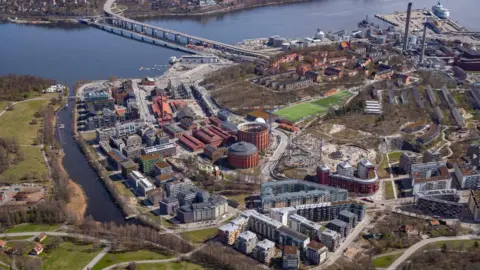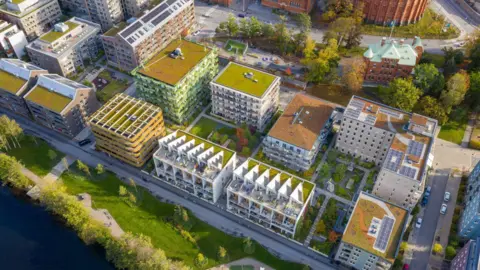Town revamp plan inspired by Sweden's capital
 City of Stockholm
City of StockholmPlans for a new town neighbourhood is taking inspiration from a Swedish city.
Wirral Council said it was looking at the Royal Seaport in Stockholm as a possible blueprint for the planned Dock Branch Park in Birkenhead.
The Dock Branch neighbourhood plan is currently under review but councillors have said the Sweden capital's development was something they would like to replicate in the Wirral town.
If given the go-ahead, councillors believe the new neighbourhood could deliver about 1,200 new homes in the next five to 15 years to help give Birkenhead "an attractive and regionally distinctive housing offer".
 City of Stockholm
City of Stockholm The Royal Seaport in Stockholm had many industrial uses over its history as a port but by 2030 it is expected to be transformed into 12,000 new homes with a plan to bring in 35,000 jobs.
The development has won awards with its eight kilometres of coastline in an attractive location 10 minutes from Stockholm and next to the Royal National City Park.
Wirral Council said they wanted to use the Royal Seaport's development plan for the Dock Branch, "giving priority to walking and biking, followed by public transport and private cars" as well as "ensuring every day services and public transport are no further than 400m away".
It is hoped the new neighbourhood will provide a boost for Argyle Street and Market Street in Birkenhead, where there is a number of bars and cultural venues to make it "an appealing destination to live, work and visit".
The Royal Seaport aims to create a neighbourhood that is not as dependent on cars with roughly one parking space for every two flats, an element Wirral Council is hoping will be a key feature of the Dock Branch as nearly 60% of people in central Birkenhead do not have a car.
Birkenhead's regeneration has been slower to take off since outline plans for Wirral Waters were approved in 2010 and the Birkenhead 2040 framework in 2022 - with millions spent on developing plans.
For Stockholm, the situation is different with £2.2bn worth of land already owned by the city and no external funding needed, said Staffan Lorentz, head of development.
He added: "Stockholm as a city is quite unique because we have had a strategic vision from the 1920s to buy up most of the land within the city itself in order to be able to sort developments.
"We owned most of the land on the port but for 100 years, it has only been used for industry."
Listen to the best of BBC Radio Merseyside on Sounds and follow BBC Merseyside on Facebook, X, and Instagram. You can also send story ideas to [email protected]
